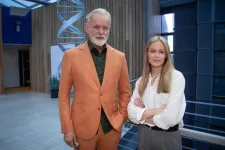(Press-News.org) A team led by CUNY Graduate Center biologists has produced a genetic analysis of Lyme disease bacteria that may pave the way for improved diagnosis, treatment, and prevention of the tick-borne ailment.
Weigang Qiu, a professor of Biology at the CUNY Graduate Center and Hunter College, and an international team including lead author Saymon Akther, a former CUNY Graduate Center Biology Ph.D. student, mapped the complete genetic makeup of 47 strains of Lyme disease-related bacteria from around the world, creating a powerful tool for identifying the bacterial strains that infect patients. Researchers said this could enable more accurate diagnostic tests and treatments tailored to the bacteria causing each patient’s illness.
“By understanding how these bacteria evolve and exchange genetic material, we’re better equipped to monitor their spread and respond to their ability to cause disease in humans,” said Qiu, the corresponding author of the study.
The study was published in mBio journal.
Researchers said the genetic information uncovered in the study may help scientists develop more-effective vaccines against Lyme disease.
Lyme disease is the most common tick-borne illness in North America and Europe, affecting hundreds of thousands of people a year. The disease arises from bacteria belonging to the Borrelia burgdorferi sensu lato group, which infect people through the bite of infected ticks. Symptoms can include fever, headache, fatigue, and a characteristic skin rash. If left untreated, the infection can spread to joints, the heart, and the nervous system, causing more severe complications.
Case numbers are increasing steadily, with 476,000 new cases each year in the United States, and may grow faster with climate change, the authors of the study said.
The research team, led by scientists from the CUNY Graduate Center and Hunter College, Rutgers, Stony Brook, and more than a dozen other research institutions, sequenced the complete genomes of Lyme disease bacteria representing all 23 known species in the group. Most hadn’t been sequenced before the effort. The National Institutes of Health-funded project included many bacteria strains most associated with human infections and species not known to cause disease in humans.
By comparing these genomes, the researchers reconstructed the evolutionary history of Lyme disease bacteria, tracing the origins back millions of years. They discovered the bacteria likely originated before the breakup of the ancient supercontinent Pangea, explaining the current worldwide distribution.
The study also disclosed how these bacteria exchange genetic material in and between species. This process, known as recombination, allows the bacteria to rapidly evolve and adapt to new environments. The researchers identified specific hot spots in the bacterial genomes where this genetic exchange occurs most frequently, often involving genes that help the bacteria interact with their tick vectors and animal hosts.
To facilitate ongoing research, the team has developed web-based software tools (BorreliaBase.org) that allow scientists to compare Borrelia genomes and identify determinants of human pathogenicity.
Looking ahead, the researchers said they plan to expand their analysis to include more strains of Lyme disease bacteria, especially from understudied regions. They also aim to investigate the functions of genes unique to disease-causing strains, which could uncover new targets for therapeutic interventions. As Lyme disease expands its geographic range because of climate change, the research provides valuable tools and insights for combating this rising public health threat.
The study is supported by grants from NIH and an award from the Steven and Alexandra Cohen Foundation.
(DOI: 10.1128/mbio.01749-24).
About the Graduate Center of The City University of New York
The CUNY Graduate Center is a leader in public graduate education devoted to enhancing the public good through pioneering research, serious learning, and reasoned debate. The Graduate Center offers ambitious students nearly 50 doctoral and master’s programs of the highest caliber, taught by top faculty from throughout CUNY — the nation’s largest urban public university. Through its nearly 40 centers, institutes, initiatives, and the Advanced Science Research Center, the Graduate Center influences public policy and discourse and shapes innovation. The Graduate Center’s extensive public programs make it a home for culture and conversation.
END
Scientists map DNA of Lyme disease bacteria
In new data, researchers see potential for better vaccines.
2024-08-15
ELSE PRESS RELEASES FROM THIS DATE:
Researchers awarded $2.8M federal grant to study potential treatment of Sudden Infant Death Syndrome
2024-08-15
CLEVELAND—More than 3,400 Sudden Unexpected Infant Deaths are reported annually in the United States, making it the country’s biggest cause of death of infants from 1 month to 1 year old, according to the Centers for Disease Control and Prevention (CDC).
Most of these deaths are classified as Sudden Infant Death Syndrome (SIDS), a disorder with numerous, unexplained causes that have plagued researchers for decades.
Now, with a new five-year, $2.8 million grant from the National Institutes of Health, researchers from Case Western Reserve University and University Hospitals Rainbow Babies ...
Blood pressure levels impacted by chronic occupational noise exposure
2024-08-15
Noise exposure is a known occupational hazard in some jobs, particularly for hearing loss, physical and psychological stress, and reduced concentration. A new study presented at the ACC Asia 2024 conference found in adult power loom weavers, chronic noise exposure not only increased their blood pressure overall, but also each year of exposure increased their odds of having high blood pressure by 10%.
“While the mechanism is still not well-explored, it is thought that the stress response by the body to chronic sound exposure causes hormonal imbalances that gradually leads to a permanent elevation of blood pressure,” said Golam Dastageer Prince, MBBS, MPH, medical officer ...
New study finds chronic high caffeine consumption may heighten risk for cardiovascular disease
2024-08-15
From coffee to tea, caffeinated beverages are an integral part of morning routines across the globe, but these popular drinks can be harmful when enjoyed in excess. According to a new study being presented at ACC Asia 2024 in Delhi, India, drinking over 400 mg of caffeine per day on most days of the week could increase the susceptibility of otherwise healthy individuals to cardiovascular disease.
“Regular caffeine consumption could disturb the parasympathetic system, leading to elevated blood pressure ...
$1.2 million in federal funding to study women Veterans experiencing homelessness
2024-08-15
A first-of-its-kind study led by Lawson Health Research Institute is receiving $1.2 million in funding from the federal government, delivered through the Veteran Homelessness Program, to better understand homelessness amongst women in Canada who are military Veterans.
“This is an important and yet often invisible problem,” says Dr. Cheryl Forchuk, Lawson Assistant Scientific Director based at St. Joseph’s Health Care London’s Parkwood Institute and the study lead. “This is the first Canadian study to focus exclusively on women Veterans’ experience of homelessness. Gender matters, especially when we’re talking ...
Robot planning tool accounts for human carelessness
2024-08-15
PULLMAN, Wash. -- A new algorithm may make robots safer by making them more aware of human inattentiveness.
In computerized simulations of packaging and assembly lines where humans and robots work together, the algorithm developed to account for human carelessness improved safety by about a maximum of 80% and efficiency by about a maximum of 38% compared to existing methods.
The work is reported in IEEE Transactions on Systems Man and Cybernetics Systems.
“There are a large number of accidents that are happening every day due to carelessness – most of them, unfortunately, from human errors,” said lead ...
deCODE genetics: Rare sequence variants, that associate with a high risk of Parkinson‘s Disease
2024-08-15
Scientists at deCODE genetics, a subsidiary of AMGEN, have discovered rare sequence variants, predicted to cause a loss of function of ITSN1, that are associated with a high risk of Parkinson‘s Disease. The findings also support less studied pathways involved in the pathogenesis of the disease.
The study, published today in npj Parkinson‘s Disease, used whole-genome sequence data from Iceland (deCODE genetics), the UK (UK Biobank), and the US (Accelerating Medicines Partnership Parkinson‘s ...
Cleaning up the aging brain: Scientists restore brain's trash disposal system
2024-08-15
Alzheimer’s, Parkinson’s, and other neurological disorders can be seen as “dirty brain” diseases, where the brain struggles to clear out harmful waste. Aging is a key risk factor because, as we grow older, our brain's ability to remove toxic buildup slows down. However, new research in mice demonstrates that it’s possible to reverse age-related effects and restore the brain’s waste-clearing process.
“This research shows that restoring cervical lymph vessel function can substantially rescue the slower removal of waste from the brain associated with age,” said Douglas Kelley, PhD, a professor of Mechanical ...
Zebrafish use surprising strategy to regrow spinal cord
2024-08-15
Zebrafish are members of a rarefied group of vertebrates capable of fully healing a severed spinal cord. A clear understanding of how this regeneration takes place could provide clues toward strategies for healing spinal cord injuries in people. Such injuries can be devastating, causing permanent loss of sensation and movement.
A new study from Washington University School of Medicine in St. Louis maps out a detailed atlas of all the cells involved — and how they work together — in regenerating the zebrafish spinal cord. In an unexpected finding, the researchers showed that survival and adaptability of the severed neurons themselves is required for full spinal cord regeneration. ...
Bone fracture rates vary dramatically by race
2024-08-15
A new paper in the Journal of Bone and Mineral Research, published by Oxford University Press, finds that bone fracture rates in older women differ by race, quite significantly. While researchers have known for years that the risk of bone fracture is highest for White women, this is the first study to show the real fracture rate for Asian and Hispanic women.
Until recently researchers have had limited data on fracture rates by specific race and ethnicity beyond White people, and even less fracture data within race and ethnic groups. Hispanic and Asian populations are the ...
2024 Shanghai Ranking: Hebrew University rises to 81st, showcasing academic excellence
2024-08-15
For the second consecutive year, three Israeli universities are ranked among the top 100 institutions globally. Alongside the Hebrew University, ranked 81st, are the Technion (85th) and the Weizmann Institute (69th). This is an outstanding achievement for Israeli academia and especially for the Hebrew University.
Professor Asher Cohen, President of the Hebrew University, stated: "The presence of three Israeli universities in the list of the top 100 universities globally is an exceptional achievement in such a challenging and complex year. The Hebrew University's rise to 81st place ...
LAST 30 PRESS RELEASES:
Auburn Physics PhD student earns prestigious DOE Fellowship
AI tool helps you learn how autistic communication works
To show LGBTQ+ support, look beyond Pride Month
Using artificial intelligence to understand how emotions are formed
Exposure to wildfire smoke late in pregnancy may raise autism risk in children
Breaking barriers in lymphatic imaging: Rice’s SynthX Center leads up to $18 million effort for ‘unprecedented resolution and safety’
Dhaval Jadav joins the SETI Institute Board to help spearhead novel science and technology approaches in the search for extraterrestrial life
Political writing retains an important and complex role in the national conversation, new book shows
Weill Cornell Medicine receives funding to develop diagnostic toolbox for lymphatic disease
It started with a cat: How 100 years of quantum weirdness powers today’s tech
McGill researchers identify a range of unexpected chemical contaminants in human milk
Physical therapy research highlights arthritis’ toll on the workforce — and the path forward
Biomedical and life science articles by female researchers spend longer under review
Forgetting in infants can be prevented in mice by blocking their brain’s immune cells
Blocking immune cells in the brain can prevent infant forgetting
AI-driven ultrafast spectrometer-on-a-chip: A revolution in real-time sensing
World enters “era of global water bankruptcy”; UN scientists formally define new post-crisis reality for billions
Innovations in spatial imaging could unlock higher wheat yields
A twitch in time? Quantum collapse models hint at tiny time fluctuations
Community water fluoridation not linked to lower birth weight, large US study finds
Stanford University’s Guosong Hong announced as inaugural recipient of the SPIE Biophotonics Discovery’s Impact of the Year Award
Ice, ice, maybe: There’s always a thin layer of water on ice — or is there?
Machine learning lends a helping ‘hand’ to prosthetics
Noninvasive brain scanning could send signals to paralyzed limbs
Community water fluoridation and birth outcomes
SGLT2 inhibitors vs GLP-1 receptor agonists for kidney outcomes in individuals with type 2 diabetes
Long-term exposure to air pollution and risk and prognosis of motor neuron disease
Five-year absolute risk–based and age-based breast cancer screening in the US
Study finds elevated alcohol involvement in suicides of lesbian, gay and bisexual women
Air pollution may increase the risk of the neurodegenerative disease ALS
[Press-News.org] Scientists map DNA of Lyme disease bacteriaIn new data, researchers see potential for better vaccines.



